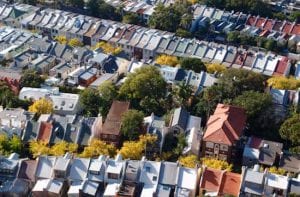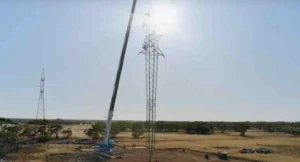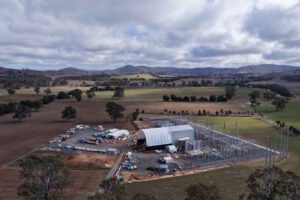ACT energy users will face rises in their electricity bills as recent falls in wholesale electricity prices are balanced out by higher payments agreed with wind and solar power providers, the territory’s network utility has warned.
Evoenergy, which owns and operates the ACT’s electricity networks and is half-owned by the ACT government, collects the feed-in tariff premiums from consumers through additional network charges.
It said on Tuesday that ACT consumers should be prepared for an increase in the network charges component of their bill due to the need to recoup additional renewable energy premiums, which have widened due to the recent falls in wholesale prices.
Evoenergy has asked the Australian Energy Regulator, which regulates the fees that can be imposed on electricity users to recover the costs of network investment, to approve a 130 per cent increase in network charges – that the utility says is necessary to recoup the feed-in-tariff payments made to the ACT’s suppliers of renewable electricity.
“What we’ve seen over the past year is a significant drop in wholesale electricity prices which has increased the payments Evoenergy has had to make under the scheme,” Evoenergy CEO John Knox said.
“This has resulted in a tripling of the funds Evoenergy requires to make large-scale feed-in tariff payments to generators, from around $42 million in the current financial year to $127 million in 2021–22.
“We understand passing through any increase is difficult for the ACT community, let alone one of this size. The significant jurisdictional charge increase, combined with smaller transmission and distribution charge increases, is expected to result in an average network increase of around 41 per cent higher than 2020–21.”
Evoenergy estimates the higher network charges will translate to a $5 per week increase for the average residential customer and around $32 per week for smaller commercial customers.
While the increase in network charges sought by Evoenergy is significant, the fees are only a portion of the total electricity price paid by consumers, representing around 40 per cent of retail electricity tariffs.
The network tariff increases are also expected to be at least partially offset by decreases in wholesale electricity costs, which are around 45 per cent lower than they were two years ago. Wholesale electricity prices make up around one-third of the final retail electricity tariff.
ACT minister for energy and emissions reduction Shane Rattenbury said the actual end impact on electricity prices could be $3.70 a week, when all impacts are accounted for, and the final tariffs won’t be known until the AER makes its final determination in May.
“The exact impact on household bills will be known at that time, but the current estimate is that the cost for the typical household will increase from $1.94 per week to $5.65 per week, an increase of around $3.70 per week or $192 per year. This is still largely in line with the original projections of the total scheme cost, which was $5.50 per household per week,” Rattenbury said.
“Based on analysis by the ACT’s Independent Competition and Regulatory Commission in 2020, the average annual electricity bill for customers in the ACT will remain comparable with other jurisdictions, even once this anticipated cost increase is taken into account. We will continue to work with Evoenergy to keep the cost of electricity as low as possible.
Rattenbury noted the cost of the ACT’s Feed-in tariff scheme has been well below forecast levels for several years, which has resulted in lower household electricity costs than would have otherwise occurred, returning savings through lower electricity bills.
“Because of our’ contract for difference’ arrangement, where we guarantee the renewable energy generators a fixed price for the electricity they generate, this leads to an increase in the price of meeting our 100% target,” Rattenbury said.
“When wholesale prices are higher than this amount, we save money, and when they are lower than this price, we pay the difference between the two, which is passed through in electricity bills.”
While the ACT led the rest of the country in securing supplies of electricity from wind and solar farms – enough to meet an equivalent of 100 per cent of the ACT’s electricity needs – the territory secured those supplies by agreeing to purchase power at a locked-in price for a period of 20-years.
These fixed prices had proven to be a blessing in past years when electricity prices surged to record highs, shielding consumers to such an extent that several of the wind farms contracted to the ACT government were required to made payments back to ACT consumers for revenues received above the fixed tariffs.
For example, the average price premium paid by ACT energy users in the quarter between January to March 2019 was an estimated negative $11 per megawatt-hour, working to shield ACT consumers from higher electricity prices.
However, as wholesale electricity prices have fallen from highs of around $90 per megawatt-hour in 2018, to below $50 per megawatt-hour in the 2021 year to date, the premium paid by ACT consumers to effectively top up the premium tariffs paid to wind and solar farms have increased.
In the most recent reporting quarter, covering the period between July to September 2020, ACT energy users paid an average price premium of around $58 per megawatt-hour.
The Australian Energy Regulator published a range of pricing proposals that it has received from network operators, kick-starting the regulatory process for setting network tariffs for the 2021-22 financial year that allow network operators to recoup the costs of their investments in poles and wires.
The proposal submitted by Ausgrid, which services much of New South Wales, would see network charges imposed on average households increase by $17 annually. The proposal from South East Queensland’s network operator Energex would see average network tariffs increase by around $5 annually, while network charges for users served by South Australia’s SA Power Networks would remain virtually unchanged.







